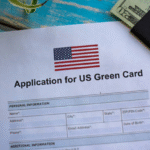Every year, millions of hopeful travelers see their dreams paused at the visa window. In fact, about 6.3% of U.S. visitor visa (B-1/B-2) visa applications end in refusal, while the student F-1 category faced a 36% rejection rate in 2024. In the Schengen zone, 16% of short-stay visas were turned down in 2023 which is down slightly from 17.9% the year before. And in the U.K., nearly 19% of entry-clearance visas were refused by March 2023.
In 2024 alone, the U.S. Department of State data reported that refusal rates for some countries increased by 10-20% compared to previous years. This shows that the process of getting a visa is becoming stricter. All these often leave applicants scratching their heads over what went wrong; then they often ask questions like; What are the common reasons for visa rejection? How can I avoid them? If you’ve ever wondered why those stamps get withheld and, more importantly, how to make sure yours isn’t, you’re in the right place.

READ ALSO: 45 Visa Free Countries Nigerians Can Travel To
Common Reasons for Visa Rejection
Visa applications can be turned down for a variety of avoidable missteps. Below, you’ll find detailed explanations of the top reasons for visa denials and practical strategies to avoid each pitfall.
1. Incomplete or Inaccurate Documentation
One leading cause of visa refusal is missing or incorrect paperwork. Consular officers need every required form, properly filled out and signed, along with supporting documents like passports, photographs, and civil certificates. For example, failing to include a valid passport copy or using an outdated visa application form kills your application before the visa officer even reviews your eligibility.
To avoid this, use the latest forms from official embassy or consulate websites, and create a checklist of every required item. Have a trusted friend or immigration advisor review your packet to catch typos or omissions. If any document isn’t in the official language, include a certified translation—otherwise, it won’t count.
2. Insufficient Financial Evidence
Visa officers must see that you can support yourself (and any dependents) while abroad without becoming a public charge. Applications lacking clear bank statements, sponsorship letters, or proof of assets often get refused under Section 214(b) of the U.S. Immigration and Nationality Act—“failure to establish entitlement to nonimmigrant status”.
How to strengthen your case: Provide up-to-date bank statements covering at least three months, pay stubs, income tax returns, and letters from employers confirming your salary and approved leave. If someone else sponsors you, include an Affidavit of Support and their bank statements. For students, scholarships or education loans should be documented clearly.
READ ALSO: How to Travel Now and Pay Later in Nigeria
3. Weak Ties to Your Home Country
One of the most cited reasons for tourist and student visa denials is the officer’s doubt that you’ll return home after your visit or studies. Without convincing “ties”—such as stable employment, property ownership, or family obligations—officers may suspect you intend to overstay.
To counter this, present documents like employment letters stating your leave dates, property deeds, or proof of ongoing education. Family ties (marriage certificate, birth certificates of children) also help. For example, a UAE applicant with a full-time job and two young children had an 80% chance of approval compared to 50% for a single applicant with no clear ties.
4. Misrepresentation and Fraud
Any hint of dishonesty—fake documents, inconsistent statements, or undisclosed facts—will lead to an ineligibility finding under INA Section 212(a)(6)(C). Even minor misstatements about previous travel or employment can be treated as fraud.
Best practice: Always tell the truth. If you’ve had past visa denials or overstay incidents, disclose them and explain what changed. Use genuine documents and avoid temptations like counterfeit invitations or employment letters. Fraud grounds require a waiver in limited cases, which is expensive and time-consuming.
5. Previous Immigration Violations and Overstays
A history of overstaying a prior visa or working without authorization can create a presumption of noncompliance and lead to immediate refusal or bans under the “unlawful presence” provisions. For instance, a simple 2–6 month overstay can trigger a three-year bar to reentry, and overstays over 180 days can lead to a ten-year bar.
To mitigate this, keep careful track of your permitted stay dates and depart before your visa expires. If you ran into unforeseen delays, consult an immigration attorney to explore options like “deferred inspection” at a port of entry or a timely-filed extension application.
READ ALSO: Difference Between Permanent Residence and Citizenship
6. Criminal and Security-Related Inadmissibility
Convictions for controlled substances, serious crimes, or political offenses can make you ineligible under INA Sections 212(a)(2) and 212(a)(3). Even arrests without conviction sometimes warrant additional scrutiny.
Avoidance tips: If you have a criminal record, consult qualified legal counsel to determine if you need a waiver of inadmissibility before applying. For minor offenses long ago, gather court records showing the disposition and any rehabilitation. Countries like Canada and Australia offer rehabilitation processes for certain convictions—research these thoroughly.
7. Medical and Health Grounds
Visa applicants must pass a medical examination to ensure they do not pose public health risks, such as having a communicable disease. Failure to complete or clear this exam leads to inadmissibility under INA Section 212(a)(1).
Preparation: Schedule your exam early with an approved panel physician. Bring all vaccination records and prior medical documents. If you have a treatable condition, complete treatment in advance and obtain a doctor’s letter confirming you no longer risk public health.
8. Poor Interview Preparation
A surprising number of denials stem from nervous or underprepared applicants who miss appointments, arrive late, or can’t answer basic questions about their trip. Even stumbling through questions about your job, itinerary, or finances can raise red flags.
How to nail it: Practice common visa interview questions with a friend or coach—cover your purpose, duration, funding, ties to home, and past travel. Aim for concise, honest answers, and bring organized folders of your documents. Being punctual, well-dressed, and polite also makes a positive impression.
READ ALSO: 22 Countries That Grant Citizenship By Birth
9. Choosing the Wrong Visa Category
Applying under an inappropriate visa class—like using a tourist visa for business negotiations or enrolling in studies on a visitor visa—leads to categorical ineligibility. Each visa type has explicit purposes and restrictions.
Avoidance: Research the exact visa category that matches your intent. For business visits, use a B-1; for tourism, B-2; for study, F-1 or J-1. If your purpose changes, file the correct change-of-status application with USCIS before you violate terms.
10. Technical and Administrative Errors
Small mistakes like paying the wrong fee, missing a signature, or submitting blurry photos—can trigger outright form rejection or delays . Some embassies return unprocessed files for correction, extending wait times by months.
Pro tip: Double- and triple-check every page before mailing. Use the embassy’s fee calculator to confirm payment amounts and preferred methods (bank draft vs. credit card). Ensure photos meet precise biometric standards: size, background color, and head position per guidelines.

READ ALSO: How To Do Change Of Name On International Passport In Nigeria
When and How to Appeal Visa Application Rejections
After a visa rejection, you can appeal certain decisions, reapply under improved conditions, and seek professional guidance to strengthen your next application. Appeal processes vary by country and visa type, but generally involve strict deadlines, formal submissions, and sometimes in-person hearings.
Reapplying requires a fresh application with new evidence showing how your circumstances have changed since the refusal. Professional advice from accredited immigration lawyers or recognized legal services—can help you navigate complex rules, avoid past mistakes, and present a compelling case. Understanding each option and acting promptly can turn a refusal into a successful outcome.
Most diplomatic missions inform you of your right to appeal and the reason for refusal in the refusal letter. For example, in the UK, you generally have 28 days from the decision date to lodge an appeal via the Immigration and Asylum Tribunal using MyHMCTS. If you’ve left the country already, you still maintain those 28 days once you receive the refusal abroad. Schengen States likewise specify appeal procedures, often starting with an informal review and escalating to a formal appeal within two months of notification.
Appeals typically require a statement of grounds, supporting evidence (e.g., extra financial proofs, new ties to home country), and payment of a fee or waiver application if you lack funds. Note that not all refusals are appealable. For instance, U.S. nonimmigrant visa refusals under INA §214(b) carry no formal appeal; instead, applicants must reapply. Successful appeals can overturn decisions, but deadlines and procedural missteps often lead to automatic dismissal.
READ ALSO: 15 Jobs In UK Nigerians Can Get On Their First Day
How to Reapply for Visa After Visa Refusal
When an appeal isn’t possible (e.g., U.S. B-1/B-2 refusals) or has failed, reapplication is your next step. You must file a new visa application, pay all applicable fees again, and present significant changes such as improved financial standing, new employment letters, or stronger home-country ties—addressing the exact reasons cited in the refusal letter.
For example, if a student permit was refused in Canada due to insufficient funds, you might secure a bank loan or scholarship letter and include it in your new application. In Australia, adding evidence that you meet character requirements, such as updated police clearances, can overcome previous rejections under the character grounds.
Reapplication timelines vary: while some embassies allow immediate resubmission, others recommend waiting three to six months to gather new evidence and avoid being perceived as repetitive applicants.
Country Specific Visa Denial Patterns
Below are some of the major patterns countries deny visa applications
United States
The U.S. Department of State’s adjusted refusal rates for B-1/B-2 tourist visas in FY2023 show a worldwide average of 6.3%, but rates vary dramatically by nationality: Nigeria at 29.23%, Kenya at 51.68%, and India at 10.99%. These higher rates often reflect perceived risks of overstays or insufficient ties.
- Key Pitfall: Applicants frequently submit outdated forms or uncertified translations, leading to immediate rejections.
- Avoidance: Use the latest USCIS and DOS forms, include certified translations, and double-check your fee payment method (bank draft vs. credit card).

United Kingdom
In the year ending March 2023, the UK granted 3.06 million visas, rejecting about 19% of applications overall. African nationals faced some of the highest refusal rates between 40% and 70% in 2023—often due to doubts about financial backing or return intent.
- Key Pitfall: Insufficient funds or absence of property deeds raise red flags under the Immigration Rules’ “maintenance” requirements.
- Avoidance: Present six months of bank statements, rent or mortgage agreements, and a letter from your employer confirming leave dates. For students, include a CAS and proof of tuition payment.
Schengen Area
Schengen countries denied approximately 12% of short-stay visa applications in 2023, generating over £110 million in refusal fees, with African applicants incurring £46 million of that total. Common issues include missing travel medical insurance and unclear itineraries.
- Key Pitfall: Submitting vague travel plans without booked accommodations or transport reservations.
- Avoidance: Provide hotel bookings, a day-by-day itinerary, and minimum coverage insurance (usually €30,000) as per the Visa Code.
Canada
Canada’s refusal rate for study permits climbed from 38% in 2023 to 52% in early 2024, driven by concerns over insufficient funds, fraudulent admission letters, and poor English/French proficiency evidence.
- Key Pitfall: Loan documents lacking co-signatures or scholarship letters missing official stamps.
- Avoidance: Include detailed loan agreements, bank assessments, and scores from recognized language tests (IELTS, TEF) with a minimum band as required by IRCC.
READ ALSO: Best Places To Live In Ontario, Canada For International Students
Best Practices to Avoid Future Rejections
- Thorough Documentation: Use official checklists; include certified translations for foreign-language documents.
- Clear Financial Proof: Show sustained funds over several months, backed by bank statements, payslips, or scholarship letters.
- Strong Home-Country Ties: Submit property deeds, employment contracts, or family commitments to demonstrate return intent.
- Accurate Forms and Fees: Double-check edition dates on application forms and confirm fees via embassy calculators.
- Interview Preparation: Practice concise, truthful answers about your trip’s purpose, duration, and funding sources.
By appealing when possible, reapplying with stronger evidence, and leveraging expert advice, you transform a single refusal into a learning opportunity—and significantly boost your odds of a future visa approval.
READ ALSO: How to Apply for USA Green Card, Steps And Requirements
Conclusion
Visa rejections often boil down to fixable preparation gaps rather than your qualifications. By gathering complete, accurate documentation; demonstrating strong home-country ties; showing robust financial backing; preemptively addressing any inadmissibility issues; and arriving at your interview calm, informed, and honest, you can significantly boost your approval odds.
If you’re ever in doubt, seek advice from accredited immigration advisors or legal experts before submitting your application. If your refusal is appealable, act quickly; otherwise, wait a few months to reapply with new supporting evidence and consider professional guidance to steer clear of past errors. Now that you’re armed with these insights and strategies, you’re well positioned to transform a visa setback into a future approval. I hope you find this article helpful.





